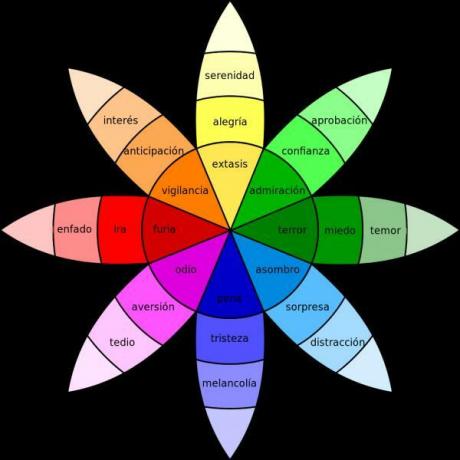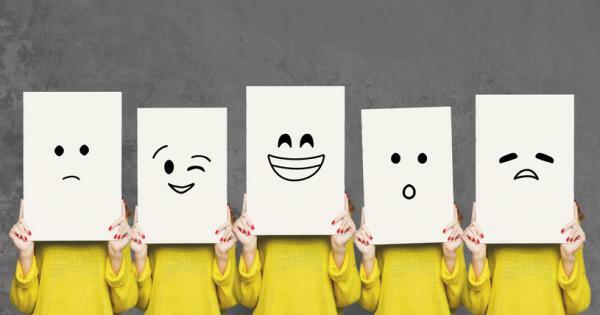
Throughout the day we experience a large number of different emotions, but many times we are unable to identify what we are feeling. The psychologist Robert Plutchik defended that emotions change throughout the evolution of the human being to adapt to their context and developed a resource in the form of a drawing that facilitates the recognition and understanding of the complexity of emotions. If you want to know more about this resource, he continues reading this article from Psychology-Online: Robert Plutchik's Wheel of Emotions.
Index
- Robert Plutchik's Wheel of Emotions
- What is the wheel of emotions
- How to use the wheel of emotions
- What is the wheel of emotions for?
- Basic emotions
Robert Plutchik's Wheel of Emotions.
Robert Plutchik was an American psychologist who developed a model of emotions based on the psycho-evolutionary theory of emotions. This theory defends that the emotional map of both human beings and animals has evolved with the aim of adapting to the external environment. For Plutchik, emotions are neither good nor bad in themselves, but all are necessary and have specific functions that promote survival and adaptation. From this conceptualization of emotions, this psychologist elaborated in 1980
What is the wheel of emotions.
What is the wheel of emotions? The wheel of emotions is a graphic resource in the form of a flower with eight petals of different colors, there is also the conical model, that shows and identifies the different emotions and the relationships that are established between them. How does the wheel of emotions work? The wheel of emotions theory is based on the criteria of typology, antagonism and intensity:
1. Typology
Emotions are divided into basic and compound emotions:
- The basic emotions They are located in the central nucleus of the whole circle, in the second circumference and are: joy, confidence, fear, surprise, sadness, aversion, anger and anticipation.
- The rest of the emotions that appear are classified as compound or secondary emotions.
2. Antagonism
Emotions are situated depending on their degree of similarity and discrepancy; those most similar are close and the most antagonistic are in opposition. In this way, four axes of opposition are created:
- Joy - sadness
- Anticipation - surprise
- Disgust - confidence
- Anger - fear
3. Intensity
Refers to the vertical axis of the wheel. Basic emotions present different levels of intensity, which is reflected in the strength of colors of this roulette. For this reason, the closer the emotion is to the core, the more intense it will be, and the further the lower it will be. The more intense the emotion, the more likely the person will act in a consonant way with it. For example, regarding fear, terror is more intense and fear less.

How to use the wheel of emotions.
To know how to work the wheel of emotionsIt is essential to understand the classification of emotions and their relationships according to Plutchik. As mentioned above, on this wheel we find the eight basic emotions, with greater and less intensity. The combination of these gives rise to the so-called compound emotions, which are made up of two basic emotions.
These compound or secondary emotions they are found in the outermost part of the drawing, in the area without color, and are part of the first emotional dyad. The combination of the basic emotions gives rise to a total of twenty-four compound emotions, which Plutchik classified into three different dyads, resulting in less frequent emotions.
1. Primary dyad
The first dyad is made up of the combination of the basic emotions found next to it:
- Joy + Trust → Love
- Joy + Anticipation → Optimism
- Trust + Fear → Submission
- Fear + Surprise → Alarm
- Surprise + Sadness → Disappointment
- Sadness + Disgust → Regret
- Disgust + Anger → Contempt
- Anger + Anticipation → Aggression
2. Secondary dyad
The second dyad is formed by the combination of basic emotions with a degree of separation:
- Joy + Fear → Guilt
- Joy + Anger → Pride
- Confidence + Surprise → Curiosity
- Trust + Anticipation → Fatalism
- Fear + Sadness → Despair
- Surprise + Disgust → Disbelief
- Sadness + Anger → Envy
- Disgust + Anticipation → Cynicism
- Anger + Sadness → Envy
3. Tertiary dyad
The third dyad is the result of the mixing of basic emotions with two degrees of separation:
- Joy + Surprise → Delight
- Joy + Disgust → Morbidity
- Trust + Sadness → Sentimentality
- Trust + Anger → Domination
- Fear + Disgust → Shame
- Fear + Anticipation → Anxiety
- Surprise + Anger → Outrage
- Sadness + Anticipation → Pessimism
What is the wheel of emotions for?
The wheel of emotions is an extremely valuable resource, which can be useful for different purposes and in various areas of psychology:
- Facilitates the classification of emotions in a relatively simple and visual way, simplifying an extremely complex subject.
- It makes it possible to identify emotions more precisely and clearly.
- It stimulates the understanding of the relationships and interrelationships between the different emotional states, the understanding that the Emotions are not presented in isolation and a stimulus can trigger a variety of different emotional reactions. intensities.
- Promotes the empathy and understanding of other people's emotions.
- Encourages the detection of triggering events of emotions.
- Help in emotional expression because it facilitates the attention and identification of one's own emotions.
- Increases the ability to manage and handle emotions due to emotional understanding.
- It can be very useful from educational psychology and emotional education, as a learning tool. The wheel of emotions is very useful for working with children.
- From the clinical psychology and therapy like self-knowledge resource and tool for the acquisition of own self-regulation resources.

Basic emotions.
According to Ekman's psychological theory there are a total of 6 basic emotions. These are surprise, disgust, fear, anger, joy, and sadness. These emotions would be universal, present in all cultures.
However, Plutchik identifies a total of eight basic emotions. What are the basic emotions according to Robert Plutchik? This psychologist establishes the same emotions as Ekman as basic, but adds two more. He defends that emotions are not positive or negative per seRather, he establishes that all of them have a concrete and adaptive function. These can be activated consciously or unconsciously, but they act as precursors of a series of behaviors that guarantee survival. Below we show the list of basic emotions according to Plutchik They are:
- Joy: Expansive emotion resulting in increased energy is activated by positive events. Its function is to reproduce those actions that generate it and to open up to people.
- Afraid: the fear in psychology it is an emotion of survival that prevents danger, allows us to act with caution and is activated by the perception of a threatening stimulus. Its function is the orientation towards protection.
- Sadness: introspective emotion that allows the reorganization of the person and the coping of losses, since it is activated before them. Its function is that of reintegration, the recognition of the loss and the knowledge of one's own limits. Here you will find more information about the sadness.
- Disgust: Survival emotion that prevents danger, is activated by the perception of objects, substances or even entities that are threatening to us. Its function is that of protection through the generation of rejection.
- Go to: emotion that connects with force, is activated in the face of frustration, deception or when the energy of our desire and goal is blocked by an obstacle. The role of the go to it is the mobilization of energy aimed at causing a change in a situation that bothers us, as well as the destruction of danger.
- Surprise: emotion that is activated by the unexpected or unforeseen. The function of this emotion is orientation, since it facilitates the processes related to attention and exploration.
- Confidence: emotion related to security and hope in the positive aspects. Its function is the incorporation, and allows to generate social ties and support.
- Anticipation: It is the emotion linked to the search for resources or alternatives in advance by generating expectations. It allows preparation and its function is that of exploration.
In the following article you will find described other emotions.
This article is merely informative, in Psychology-Online we do not have the power to make a diagnosis or recommend a treatment. We invite you to go to a psychologist to treat your particular case.
If you want to read more articles similar to Robert Plutchik's Wheel of Emotions, we recommend that you enter our category of Emotions.
Bibliography
- Belli, S., & Íñiguez-Rueda, L. (2008). The psychosocial study of emotions: A review and discussion of current research. Psycho, 39(2), 139-151.
- Díaz, J. L., & Enrique, F. (2001). The structure of human emotion: a chromatic model of the affective system. Mental health, 24(4), 20-35.
- Plutchik, R. (1984). Emotions: A general psychoevolutionary theory. Approaches to emotion, 1984, 197-219.


